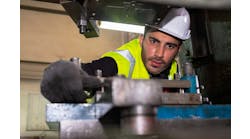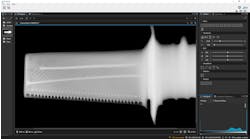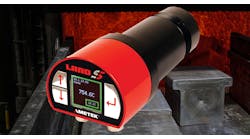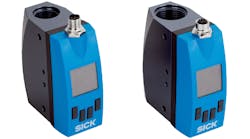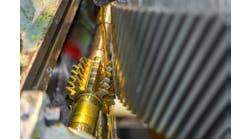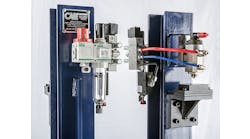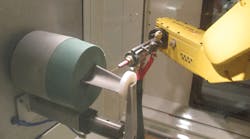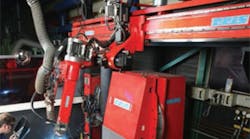Latest from Quality Control
GUYSON CORPORATION introduced a robotic blast system designed and adapted for glass-bead peening in Nadcap-compliant manufacturing and overhaul operations that must perform surface enhancement process according to AMS 2432 peening specifications, including peening of stage-one titanium fan blades.
The 7-axis RB-9 peening machine incorporates a Fanuc M-10iA (or comparable) robot as a blast gun manipulator, and a servomotor drive that orients the machine’s turntable as a coordinated auxiliary axis of robotic motion. During a peening cycle, the robotic blast system constantly maintains the correct nozzle angle, offset, and surface speed as it traces the contours of the part. The Fanuc robot design includes a hollow wrist that allows the air and media hoses of the suction-blast gun, as well as the air supply hose for the separate blow-off nozzle, to be routed through the arm of the robotic nozzle manipulator.
A 36-in. diameter, 500-lb. capacity rotary table includes T-slots and is mounted on a powered transfer cart to simplify installation and changing of component-holding fixtures. Also, the 48x48x48-in. cabinet is provided with a rubber-flapped and covered channel in the roof of the blasting enclosure and a 500-lb. capacity roof-mounted jib crane to ease loading and unloading of heavy components.
In addition to a cyclone separator for removing dust and fines, the peening shot reclamation system of the RB-9 glass bead peening machine includes a vibratory screen classifier to maintain strict control over shot sizing, and a spiral separator to prevent non-spherical or fractured beads from being fed to the blast gun. Digital electronic sensors, closed-loop computer controls, and data acquisition software not only provide real-time monitoring and control of critical peening process parameters, such as blast pressure, glass bead supply and shot flow: they capture and automatically log all data that are required to document that the work was done as specified, and verify the integrity of the surface enhancement process for each part peened.
The HMI of the RB-9 glass bead peening machine features a touch-screen panel that is designed to represent each element of the system graphically, indicate its current status clearly, and display moment-to-moment data regarding its performance. The robotic blast machine’s manufacturer claims the HMI is more intuitive and easier to use than the control panels found on gantry-type CNC peening equipment.
Visit www.guyson.com/robotics



